The Enigma Of The ‘Ancient Ones’, The Anasazi Cliff-Dwellers Of The Southwestern United States
Thalia Lightbringer - AncientPages.com - No one really knows for certain what happened to the Anasazi. They attained a high level of culture for their time, then abandoned it all.
Did they exhaust their resources then lose faith in their way of life? Could they have had competition for the dwindling food and water sources from other tribes migrating to their area?
From Nomadic Beginnings To Complex Culture
The Anasazi began as nomadic hunter-gatherers, perhaps as early as 1500 BC. They occupied the valleys and plains in the “Four Corners” region of North America (where Utah, Colorado, Arizona, and New Mexico meet at the corners). They eventually adapted into a basket maker culture, clustering together in settlements with pit houses around 300-700 AD. Then for some reason they felt the need to change their ways drastically.
After this time, the Anasazi built great cities and ceremonial centers with kivas, special sacred buildings which were usually built underground with a hatchway at the top, which were used for religious rituals. The kivas are also associated with the Pueblo and Hopi tribes, connected with their belief in the Kachina spirits. The hatchway was symbolic of the gateway between our world and the “fourth world”, realm of the spirits.
The Anasazi may have adopted some of the ritual beliefs from other people coming to the area, since the Kachinas are thought to bring rain and fertility. These things became very important to them at the end of their culture.
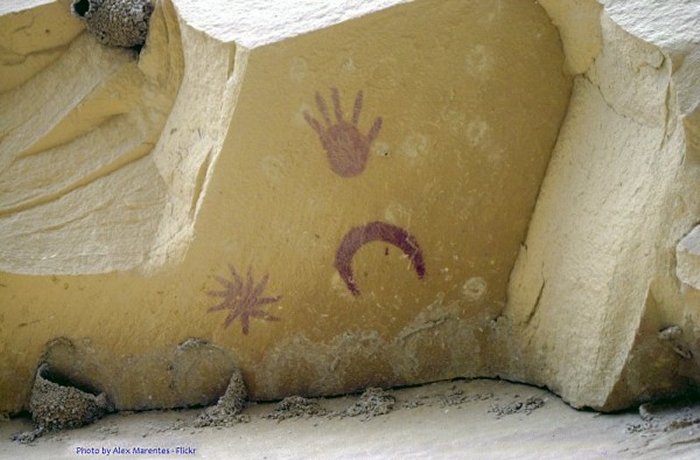
Anasazi pictograph possibly depicting the Crab Nebula supernova in AD 1054. Chaco Canyon, New Mexico
The Anasazi studied the stars and developed complex calendars, using astronomical observations to pinpoint the proper times for sowing and harvesting their crops. Chaco Canyon in New Mexico seems to have been a center for astronomical studies and sacred ceremonies.
They did not have a written language, but left behind beautiful petroglyphs, symbolic art carved into the rocks. In their final period of development, the Anasazi moved to barely accessible canyons, building cliff houses surrounded by high walls in places with natural springs, such as at Mesa Verde, Colorado. This period of cultural development lasted until around 1300 AD. Then they seem to have decided to suddenly abandon all their achievements, some even leaving their possessions behind.
Need For Defense?
The Anasazi are often called the “Ancient Ones”, but the term comes from a Navajo word meaning “ancestors of our enemies”. Archaeologists refer to them as the "Mogollon" culture. We do not know what they called themselves, but the Hopi claim that the Ancient Ones are their ancestors. This might give us a clue as to why the Anasazi abruptly left their settlements less than 50 years after accomplishing the amazingly difficult feat of building dwellings sheltered high in canyon cliffs.
The Hopi are an extremely peaceful people, rarely engaging in warfare. They have been known to leave a settlement rather than fight with another tribe over it. The Navajo are believed to have come to the area from the north (based on similarities with the language of the Athabascan tribe in Canada) at around 1400 AD. Perhaps some of them arrived earlier than this and the Anasazi decided to leave, avoiding potential conflict. The building of cliff dwellings seems to point to a need for defense. Not only are they difficult to reach, but also quite hard to see unless you know what you are looking for.
Drought And Famine Leading To Loss Of Faith?
Another idea is that they had exhausted the resources of the area and after years of drought were losing faith in their traditions. There is a tale of a Hopi leader who asked a neighboring tribe to slaughter his people in the night, because they had strayed too far from their values.
It seems the Anasazi would also sacrifice themselves for their traditions. There have been remains found which indicate such sacrifice in the kivas of some Anasazi ruins, but seemed to be little or no evidence of violent conflict. However, more recent findings show that this was not always true and it is possible that the settlements fought amongst themselves, perhaps because of dwindling resources.
Since they used wooden beams in the construction of their dwellings, we know when they lived and that there were many years of drought. Accurate dates and information about the climate of the time has been obtained from these wooden supports using dendrochronology, a method of dating using tree rings.
Tree rings show that they had successfully survived periods of drought before, but maybe the final drought was compounded by other factors. Archaeologists have also found indications that hunger got so bad at the end that they resorted to cannibalism in some instances, though it is also possible that marauding enemies were responsible for this. Native legends speak of such raiders coming to the area.
It is now believed the Anasazi migrated to the Hopi mesas and Rio Grande Valley, and are now known as the Hopi, Zuni and Pueblo tribes. Traditional tales of these people support some scientific findings that the exodus may have occurred gradually, in small groups, over a hundred-year period. Perhaps they just decided to go back to a simpler life, remembering their nomadic past when their traditions failed to save them from drought and hunger.
If you enjoyed this article consider becoming a member. Our member section offers a wealth of informative and insightful articles similar to this one. Upgrading to a premium membership gives you access to all our articles, including our library of ancient and unexplained mysteries.
Updated on August 6, 2024
By Thalia Lightbringer – AncientPages.com Writer
Copyright © AncientPages.com All rights reserved. This material may not be published, broadcast, rewritten or redistributed in whole or part without the express written permission of AncientPages.com
More From Ancient Pages
-
 Ancient Quest For Mechanical Life: Humanoid Robots Of Our Ancestors
Ancient Technology | Apr 26, 2019
Ancient Quest For Mechanical Life: Humanoid Robots Of Our Ancestors
Ancient Technology | Apr 26, 2019 -
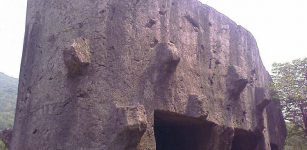 Gigantic Unfinished Stone Structures Cut With Amazing Stone-Working Techniques
Civilizations | Sep 21, 2015
Gigantic Unfinished Stone Structures Cut With Amazing Stone-Working Techniques
Civilizations | Sep 21, 2015 -
 Mysterious Fossilized Antarctic Forest May Offer Evidence Of The Great Flood – But Some Facts Speak Against This Theory
Archaeology | Dec 27, 2017
Mysterious Fossilized Antarctic Forest May Offer Evidence Of The Great Flood – But Some Facts Speak Against This Theory
Archaeology | Dec 27, 2017 -
 Fragarach: Supernatural Sword That Controlled Winds, Cut Through Wood, Metal And Bricks In Irish Myths And Legends
Celtic Mythology | May 14, 2020
Fragarach: Supernatural Sword That Controlled Winds, Cut Through Wood, Metal And Bricks In Irish Myths And Legends
Celtic Mythology | May 14, 2020 -
 How Reliable Are Computer ‘Reconstructions’ Of Faces From Ancient Times?
Featured Stories | Sep 3, 2024
How Reliable Are Computer ‘Reconstructions’ Of Faces From Ancient Times?
Featured Stories | Sep 3, 2024 -
 The Writing Ball: A Great Invention In 1870
Ancient History Facts | Jun 30, 2016
The Writing Ball: A Great Invention In 1870
Ancient History Facts | Jun 30, 2016 -
 Mysteries Of The Great Dismal Swamp – Unexplained Vanishings, Bewildering Encounters With Weird Beings, And Scary Legends
Featured Stories | Dec 22, 2024
Mysteries Of The Great Dismal Swamp – Unexplained Vanishings, Bewildering Encounters With Weird Beings, And Scary Legends
Featured Stories | Dec 22, 2024 -
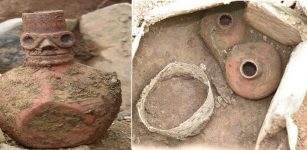 Wari Culture: Ancient Astronomical Observatory Excavated In Cusco, Peru
Archaeology | Dec 20, 2017
Wari Culture: Ancient Astronomical Observatory Excavated In Cusco, Peru
Archaeology | Dec 20, 2017 -
 Aditi – Primeval Hindu Goddess Who Is Source Of All Living Beings
Featured Stories | Apr 3, 2021
Aditi – Primeval Hindu Goddess Who Is Source Of All Living Beings
Featured Stories | Apr 3, 2021 -
 Unusual Grave Of The Trzciniec Culture Is An Archaeological Puzzle
Archaeology | Dec 23, 2019
Unusual Grave Of The Trzciniec Culture Is An Archaeological Puzzle
Archaeology | Dec 23, 2019 -
 Ancient Roman Women Wore Bikini In 1400 B.C.
Ancient History Facts | Jul 17, 2017
Ancient Roman Women Wore Bikini In 1400 B.C.
Ancient History Facts | Jul 17, 2017 -
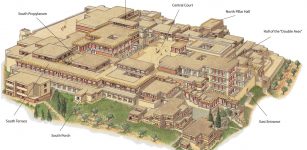 Ancient City Of Knossos – A Cosmopolitan Hub Of The Minoan Civilization And Culture
Civilizations | Jan 8, 2016
Ancient City Of Knossos – A Cosmopolitan Hub Of The Minoan Civilization And Culture
Civilizations | Jan 8, 2016 -
 Did Pharaoh Shishak Plunder King Solomon’s Temple?
Biblical Mysteries | Jan 15, 2020
Did Pharaoh Shishak Plunder King Solomon’s Temple?
Biblical Mysteries | Jan 15, 2020 -
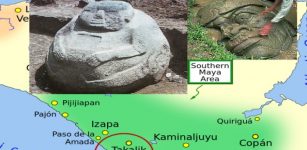 Mysterious Abaj Takalik Of Guatemala And Intriguing Relationship Between Olmec and Maya
Civilizations | Mar 16, 2020
Mysterious Abaj Takalik Of Guatemala And Intriguing Relationship Between Olmec and Maya
Civilizations | Mar 16, 2020 -
 Mystery Of The Tower Of Babel – The Mountain Of God Or A Symbol Of Chaos And Ignorance?
Ancient Mysteries | Oct 14, 2014
Mystery Of The Tower Of Babel – The Mountain Of God Or A Symbol Of Chaos And Ignorance?
Ancient Mysteries | Oct 14, 2014 -
 Baku’s Mysterious Maiden Tower – Legend Of The Daughter Of Fire Who Saved The Sacred Temple May Be True
Featured Stories | Jul 5, 2021
Baku’s Mysterious Maiden Tower – Legend Of The Daughter Of Fire Who Saved The Sacred Temple May Be True
Featured Stories | Jul 5, 2021 -
 Zagros Mountains: Home To Tribes, Kingdoms And Empires For Thousands Of Years
Civilizations | Sep 16, 2020
Zagros Mountains: Home To Tribes, Kingdoms And Empires For Thousands Of Years
Civilizations | Sep 16, 2020 -
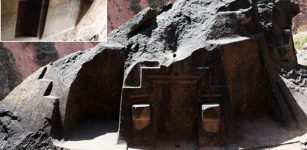 Naupa Huaca: The Enigmatic Stone Temple In A Cave In Peru
Featured Stories | Sep 10, 2020
Naupa Huaca: The Enigmatic Stone Temple In A Cave In Peru
Featured Stories | Sep 10, 2020 -
 Enigmatic Ale’s Stones – Sweden’s Megalithic Ship-Like Formation
Featured Stories | Jan 17, 2023
Enigmatic Ale’s Stones – Sweden’s Megalithic Ship-Like Formation
Featured Stories | Jan 17, 2023 -
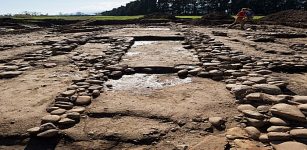 Sanctuary Of God Mithra And His Mysterious Religion Unearthed In Corsica
Archaeology | Mar 2, 2017
Sanctuary Of God Mithra And His Mysterious Religion Unearthed In Corsica
Archaeology | Mar 2, 2017



